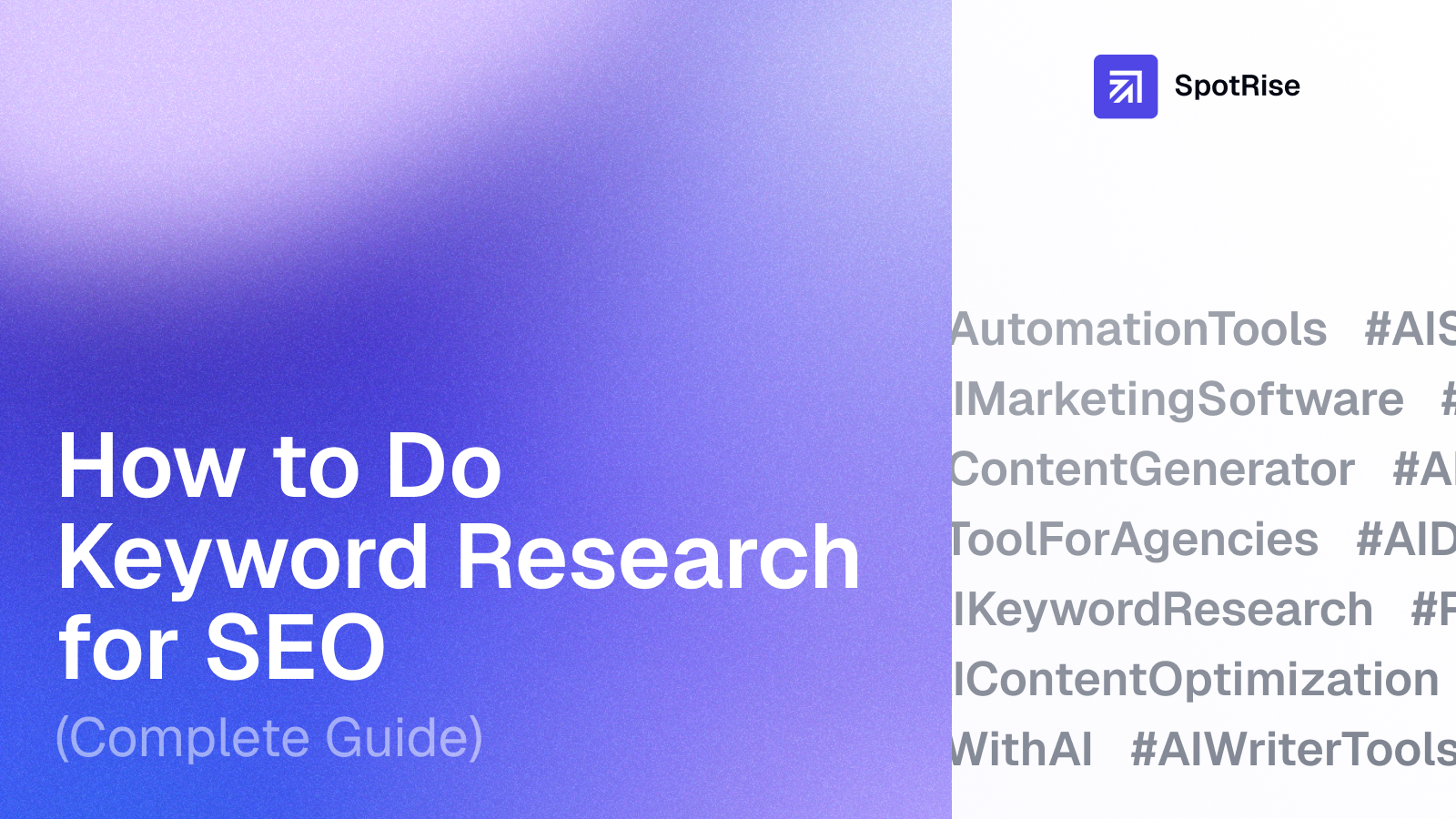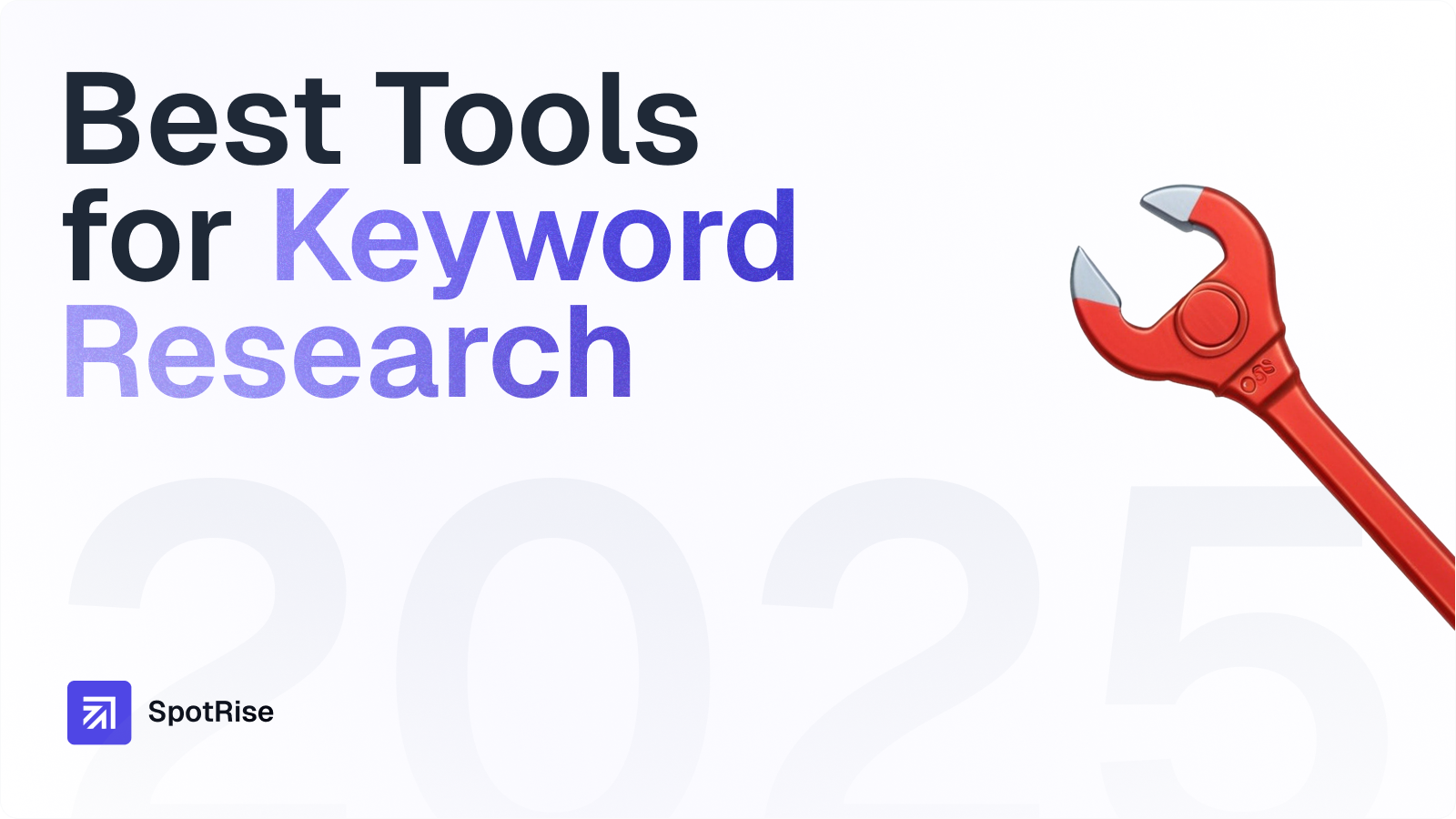November 21, 2025
Semantic Blocks: The New Structure of AI-Optimized Content
November 20, 2025
Multimodal SEO: How AI Uses Images, Video & Diagrams to Rank Pages
November 19, 2025
A short guide to finding keywords and turning them into content that ranks.
Author:

Every successful SEO strategy starts with one thing — understanding what your audience is searching for.
Keyword research is the foundation of SEO. It determines what content you create, how you optimize it, and ultimately, whether your pages bring traffic or remain invisible.
But keyword research in 2025 isn’t what it used to be. It’s no longer just about search volume and difficulty — it’s about search intent, topical clusters, AI-generated SERP features, and even visibility inside AI Overviews.
In this guide, you’ll learn how to do keyword research for SEO step by step — from brainstorming ideas to building a complete content map.
And you’ll see how AI tools like SpotRise.ai are changing the game, making keyword discovery and clustering faster than ever.
Keyword research is the process of finding, analyzing, and prioritizing the search queries that people type into Google and other search engines.
It helps you understand your audience’s language, intent, and pain points — so you can create content that actually ranks and converts.
Without proper keyword research, your SEO strategy is just guesswork.
You might write great content — but if no one searches for it, you’re shouting into the void.
Why keyword research matters:
In short, keyword research bridges the gap between what you want to say and what your audience wants to find.
Before diving into tools and data, you must understand one key principle — search intent.
Every keyword carries an intent, a reason why the user typed it. If your content doesn’t match that intent, it won’t rank — even if it’s perfectly optimized.
{{keyword1="/rich-text-elements"}}
👉 Matching the right type of content to each intent is what separates ranking content from lost content.
For instance, “how to fix a leaking tap” should be a step-by-step guide, not a product page.
Understanding intent allows you to group keywords correctly, plan your content hubs logically, and increase relevance in Google’s eyes.
Let’s walk through a complete modern keyword research workflow — the same one used by top SEO professionals and content strategists.
Start with 5–10 broad themes related to your business or niche.
These are usually product categories, problems you solve, or key services.
Example (for a fitness app):
Each of these will become a “topic cluster” later, containing multiple sub-keywords.
💡 Pro tip: Talk to your customers or read Reddit threads — people often describe problems in ways keyword tools don’t.
Seed keywords are the base queries you’ll expand from.
To find them, use free and simple sources:
Example: typing “workout app” may suggest:
Each of these is a seed keyword that can lead to dozens of long-tail variations.
Now that you have a list of seed keywords, it’s time to scale up using tools.
Best tools for keyword research:
Modern tools don’t just give you keywords — they tell you what kind of content ranks, what features appear (snippets, videos, AI summaries), and how users interact with results.
Once you have hundreds of potential keywords, narrow them down using four key metrics:
{{keyword2="/rich-text-elements"}}
Don’t chase only high-volume keywords. A low-volume, high-intent keyword can often bring more conversions than a generic high-volume one.
This is where the magic happens.
Search your chosen keyword in Google and study the top results. Ask yourself:
This SERP analysis shows what Google expects and how you can outperform competitors.
If the first page is dominated by big players, target a more specific, long-tail version.
Keyword clustering means grouping similar queries that share the same intent or SERP results.
Example cluster:
Instead of writing three articles, you create one powerful page optimized for the entire cluster.
AI-driven tools (like SpotRise) can automate this process — analyzing similarity between keywords and merging them into logical groups.
This approach not only improves topical authority but also reduces keyword cannibalization.
Long-tail keywords are longer, more specific search phrases.
They usually have:
Examples:
To find them:
Long-tails are perfect for building topical depth and answering niche questions that competitors ignore.
Once you have a full keyword list, you need to prioritize.
A smart SEO doesn’t just pick random words — they balance opportunity and effort.
Use a simple Impact vs Effort Matrix:
{{keyword3="/rich-text-elements"}}
Now that your keywords are grouped and prioritized, turn them into a content structure.
Example for a fitness site:
Main Hub: Workout Apps
→ Subtopics:
Each subtopic = one article targeting a keyword cluster.
Together, they form a content hub that signals topical authority to Google.
In the future, platforms like SpotRise.ai will automate this — mapping clusters to page templates and building content plans in one click.
Keyword research is not a one-time task — it’s a living process.
Search behavior changes, competitors rise, and AI summaries are reshaping SERPs.
Make it a habit to:
Continuous optimization ensures your keyword strategy stays fresh and future-proof.
If you’ve mastered the basics, here’s how to level up your keyword research game:
Instead of manually brainstorming, prompt AI tools to analyze your niche, competitors, and user intent.
They can suggest topic clusters based on semantic relationships and user needs — not just exact match queries.
More and more searches end without a click due to Featured Snippets, Knowledge Panels, or AI Overviews.
Find these opportunities — sometimes being mentioned in the summary is as valuable as ranking.
Align content with user stages:
This ensures your funnel captures users at every stage.
If you run ads, combine keyword performance data with organic rankings.
High CPC + high CTR = keyword with commercial potential worth targeting organically.
Even experienced SEOs make these mistakes:
Avoiding these pitfalls will instantly make your keyword research more strategic.

{{keyword4="/rich-text-elements"}}
The future of keyword research is heading toward AI-powered automation — where tools not only show keywords but understand context, intent, and traffic probability across search and AI platforms.
Keyword research is more than data — it’s about understanding your audience, the search engine, and the connection between the two.
It’s the first and most crucial step in building a content strategy that brings consistent, compounding organic growth.
By following this process — brainstorming topics, analyzing intent, clustering keywords, and prioritizing strategically — you’ll turn raw search data into an actionable SEO roadmap.
And as the industry moves toward automation and AI-driven insights, tools like SpotRise.ai will make keyword research faster, smarter, and fully integrated with the next generation of SEO workflows.
Start your keyword research today — not with spreadsheets, but with strategy.
Because the brands that understand search intent best… always rise to the top.
Your new AI assistant will handle monitoring, audits, and reports. Free up your team for strategy, not for manually digging through GA4 and GSC. Let us show you how to give your specialists 10+ hours back every week.
Read More

November 21, 2025
10 min

November 20, 2025
10 min

November 19, 2025
10 min
Just write your commands, and AI agents will do the work for you.